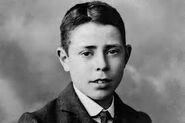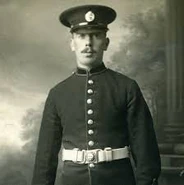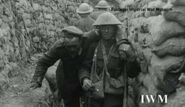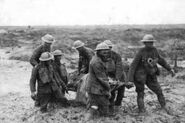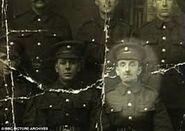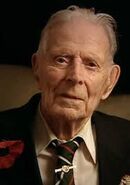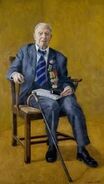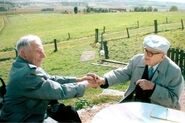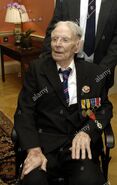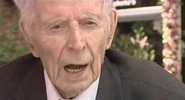(added gallery with photos) Tag: Visual edit |
(added photos) Tag: Visual edit |
||
| Line 83: | Line 83: | ||
<gallery> |
<gallery> |
||
HPatchyoung1.jpeg|Harry Patch at the age of 15. |
HPatchyoung1.jpeg|Harry Patch at the age of 15. |
||
| + | HPatch1919.jpeg|Harry Patch in 1919, aged 21. |
||
HPatchuniform.jpeg|Harry Patch in his uniform at age 22. |
HPatchuniform.jpeg|Harry Patch in his uniform at age 22. |
||
HPatchaction.jpg|Harry Patch (left) in action during WW1. |
HPatchaction.jpg|Harry Patch (left) in action during WW1. |
||
| Line 88: | Line 89: | ||
HPatchregiment2.jpeg|Harry Patch with his regiment at the end of WW1. |
HPatchregiment2.jpeg|Harry Patch with his regiment at the end of WW1. |
||
HPatcharmyb.jpg|Harry patch (far right) with some of his army buddies. |
HPatcharmyb.jpg|Harry patch (far right) with some of his army buddies. |
||
| + | HPatch and wife 1980.jpeg|Harry Patch and his wife in 1980. |
||
| + | HPatch100.jpeg|Harry Patch at the age of 100. |
||
HPatchI.jpg|An illustration of Harry Patch in his Centenarian years. |
HPatchI.jpg|An illustration of Harry Patch in his Centenarian years. |
||
HPatch107.jpg|Harry Patch at the age of 106. |
HPatch107.jpg|Harry Patch at the age of 106. |
||
Revision as of 17:22, 6 July 2020
| Harry Patch | |
 | |
| Birth: | 17 June 1898 Combe Down, Somerset, England, UK |
| Death: | 25 July 2009 Wells, Somerset, England, UK |
| Age: | 111 years, 38 days |
| Country: | |
| Validated | |
Henry John "Harry" Patch (17 June 1898 – 25 July 2009), dubbed in his latter years "the Last Fighting Tommy", was a British supercentenarian, briefly the oldest man in Europe and the last surviving soldier known to have fought in the trenches of the First World War.[1] Patch was, with Claude Choules and Florence Green, one of the last three surviving British veterans of the First World War and with Frank Buckles and John Babcock, one of the five last known veterans in the world.[2] At the time of his death, aged 111 years, 1 month, 1 week and 1 day, Patch was the third-oldest man in the world, the oldest man in Europe and the 77th oldest man ever.
Biography
Patch was born in the village of Combe Down, near Bath, Somerset, England. He appears in the 1901 Census as a two-year-old boy along with his stonemason father William John Patch, mother Elizabeth Ann (née Morris) and older brothers George Frederick and William Thomas at a house called "Fonthill".[3] The family are recorded at the same address "Fonthill Cottage" in the 1911 census.[4] His elder brothers are recorded as a carpenter and banker mason. Longevity ran in Patch's family; his father lived to 82, his mother to 94, his brother George to 95 and his brother William to 87. Patch left school in 1913 and became an apprentice plumber in Bath.[5][6]
In October 1916, during World War I, he conscripted as a private into the British Army, reporting for duty at Tolland Barracks, Taunton. During the winter of 1916–17 he was promoted lance-corporal but was demoted after a fist fight with a soldier, who had taken his boots from his billet and saw no further promotion.[7] Patch went through a series of short-lived attachments to several regiments, including the Royal Warwickshire Regiment before being posted after completing training to the 7th (Service) Battalion, Duke of Cornwall's Light Infantry, serving as an assistant gunner in a Lewis Gun section.[8] Patch arrived in France in June 1917.[9] He fought on the Western Front at the Battle of Passchendaele (also known as the Third Battle of Ypres) and was injured in the groin, when a shell exploded overhead at 22:30 on 22 September 1917, killing three of his comrades. He was removed from the front line and returned to England on 23 December 1917.[9] Patch referred to 22 September as his personal Remembrance Day. He was still convalescing on the Isle of Wight when the Armistice was declared the following November.[10]
"When the war ended, I don't know if I was more relieved that we'd won or that I didn't have to go back. Passchendaele was a disastrous battle – thousands and thousands of young lives were lost. It makes me angry. Earlier this year, I went back to Ypres to shake the hand of Charles Kuentz, Germany's only surviving veteran from the war. It was emotional. He is 107. We've had 87 years to think what war is. To me, it's a licence to go out and murder. Why should the British government call me up and take me out to a battlefield to shoot a man I never knew, whose language I couldn't speak? All those lives lost for a war finished over a table. Now what is the sense in that?"
-Harry Patch[11]
After the war, Patch returned to work as a plumber, during which time he spent four years working on the Wills Memorial Building in Bristol, before becoming manager of the plumbing company's branch in Bristol.[12] A year above the age to be called up for military service at the outbreak of the Second World War in 1939, he became a part-time fireman in Bath, dealing with the Baedeker raids.[12] [13] Later in the war he moved to Street, Somerset, where he ran a plumbing company until his retirement at the age of 65.[12]
On 13 September 1919, Patch married, at Hadley, Shropshire, Ada Billington, who died in 1976.[14] They had two sons, both of whom predeceased him: Dennis, who died in 1984 and Roy, who died in 2002.[5] At 81, he married his second wife, Jean, who died in 1984. His third partner, Doris Whittaker, who lived in the same nursing home as him, died in 2007.[15]
Last Tommy
Patch had refused to discuss his war experiences, until approached in 1998 for the BBC One documentary Veterans, on reflection of which and with the realisation that he was part of a fast dwindling group of veterans of "the war to end all wars".[10]
Patch was featured in the 2003 television series World War 1 in Colour and said "if any man tells you he went over the top and he wasn't scared, he's a damn liar." He reflected on his lost friends and the moment when he came face to face with a German soldier. He recalled the story of Moses descending from Mount Sinai with God's Ten Commandments, including "Thou shalt not kill" and could not bring himself to kill the German. Instead, he shot him in the shoulder, which made the soldier drop his rifle. However, he had to carry on running towards his Lewis Gun, so to proceed, he shot him above the knee, and in the ankle. Patch said,
"I had about five seconds to make the decision. I brought him down, but I didn't kill him.... Any one of them could have been me. Millions of men came to fight in this war and I find it incredible that I am the only one left."
—Commenting on graves at a Flanders war cemetery, July 2007.[16]
In November 2004, at the age of 106, Patch met Charles Kuentz, a 107-year-old Alsatian veteran, who had fought on the German side at Passchendaele (and served on the French side in World War II).[17] Patch was quoted as saying: "I was a bit doubtful before meeting a German soldier. Herr Kuentz is a very nice gentleman however. He is all for a united Europe and peace – and so am I". Kuentz had brought along a tin of Alsatian biscuits and Patch gave him a bottle of Somerset cider in return.[18] The meeting was featured in a 2005 BBC TV programme The Last Tommy, which told the stories of several of Britain's last World War I veterans.[19]
In December 2004, Patch was given a present of 106 bottles of Patch's Pride Cider, which has been named after him and produced by the Gaymer Cider Company.[20]
In the spring of 2005 he was interviewed by the Today programme, in which he said of the First World War: "Too many died. War isn't worth one life" and in July 2005, Patch voiced his outrage over plans to build a motorway in northern France over cemeteries of the First World War.
On 16 December 2005, Patch was awarded an honorary degree by the University of Bristol, whose buildings he helped construct in the 1920s.[21]
[22] The University's newly restored Wills Memorial Building was reopened by Patch on 20 February 2008. He was chosen for this honour as he was a member of the workforce that originally helped build the tower, which was opened on 9 June 1925 by King George V, an event which Patch also attended.[23]
In July 2007, marking the 90th anniversary of the beginning of the Battle of Passchendaele, Patch revisited the site of the battle in Flanders, to pay his respects to the fallen on both sides. He was accompanied by a historian, Richard van Emden. On this occasion, Patch described war as the "calculated and condoned slaughter of human beings" and said that "war isn't worth one life."[24]
In August 2007, Patch's autobiography The Last Fighting Tommy was published, making him one of the oldest authors ever.[25] With the proceeds from this book, Patch decided to fund an Inshore Lifeboat for the Royal National Lifeboat Institution (RNLI) and he attended the RNLI's Lifeboat College on 20 July 2007, to officially name the boat The Doris and Harry.[26]
In February 2008, the poet laureate of the United Kingdom Andrew Motion, was commissioned by the BBC West television programme Inside Out West, to write a poem in Patch's honour. Entitled "The Five Acts of Harry Patch" it was first read at a special event at the Bishop's Palace in Wells, where it was introduced by the Prince of Wales and received by Harry Patch.[27][28]
In July 2008, Wells City Council conferred the freedom of the city of Wells on Patch.[29] On 27 September 2008, in a private ceremony attended by a few people, Patch opened a memorial on the bank of the Steenbeek, at the point where he crossed the river in 1917.
The memorial reads,
"Here, at dawn, on 16 August 1917, the 7th Battalion, Duke of Cornwall's Light Infantry, 20th (Light) Division, crossed the Steenbeek prior to their successful assault on the village on Langemarck. This stone is erected to the memory of fallen comrades, and to honour the courage, sacrifice and passing of the Great War generation. It is the gift of former Private and Lewis Gunner Harry Patch, No. 29295, C Company, 7th DCLI, the last surviving veteran to have served in the trenches of the Western Front."[30]
In October 2008, Patch launched the 2008 Royal British Legion Poppy Appeal in Somerset.[31] On 11 November 2008, marking the 90th anniversary of the end of World War I, together with fellow veterans Henry Allingham and Bill Stone, Patch laid a commemorative wreath for the Act of Remembrance at The Cenotaph in London, escorted by Victoria Cross recipient Johnson Beharry.[32]
On 9 November 2008, the Master of the Queen's Music, Sir Peter Maxwell Davies attended the world premiere of his choral work paying tribute to Patch. The piece sets words by the Poet Laureate, Andrew Motion and was performed at Portsmouth Cathedral by the London Mozart Players, the Portsmouth Grammar School chamber choir and the cathedral's choristers. The creation of the work was featured in A poem for Harry, a BBC West documentary that was subsequently repeated on BBC Four. The programme won a gold medal at the New York Festivals International Television Programming and Promotion Awards.[33]
On 18 July 2009, with the death of Henry Allingham, Patch became the oldest surviving veteran and also the oldest man in the United Kingdom.[34] Patch was the last trench veteran of World War I. The penultimate Western Front veteran, the 108-year-old Fernand Goux of France, who died on 9 November 2008, fought for 8 days. He came out unscathed, unlike Patch and the last Alpine Front veteran, 110-year-old Delfino Borroni of Italy, who died on 26 October 2008. Patch was also the last surviving Tommy, since the death on 4 April 2009 of Netherwood Hughes, who was still in training when the war ended. The penultimate fighting Tommy, Harold Lawton, died on 24 December 2005. Claude Choules, the last remaining First World War naval veteran, died on 5 May 2011.[35]
We came across a lad from A company. He was ripped open from his shoulder to his waist by shrapnel and lying in a pool of blood. When we got to him, he said: 'Shoot me'. He was beyond human help and, before we could draw a revolver, he was dead. And the final word he uttered was 'Mother.' I remember that lad in particular. It's an image that has haunted me all my life, seared into my mind.
—An extract from Patch's book The Last Fighting Tommy which was read out at his funeral by Marie-France André, the chargé d'affaires of the Belgian embassy, August 2009.[36]
Medals
Harry Patch received eight medals and honours; for his service in the First World War he received the British War Medal and the Victory Medal.[37] In 1998, as a surviving veteran of the First World War, who had fought for the Allies in France and Flanders, the President of the Republic of France a Knight of the Légion d'honneur. The award was presented to Patch on his 101st birthday. On 9 March 2009, Patch was appointed an Officer of the Légion d'honneur by the French Ambassador at his nursing home in Somerset.[38] On 7 January 2008, Albert II, King of the Belgians, conferred upon Patch the award of Knight of the Order of Leopold. He received the award from Jean-Michel Veranneman de Watervliet, Belgium's Ambassador to the United Kingdom, at a ceremony in the Ambassador's residence in London, on 22 September 2008, which coincidentally was the 91st anniversary of the day he was wounded in action and three of his closest friends killed.[39]
For service during the Second World War, Patch was awarded the 1939–45 Defence Medal. This was subsequently lost and on 20 September 2008, at a ceremony at Bath Fire Station, Patch was presented with a replacement medal.[40] Patch also received two commemorative medals: the National Service Medal and the Hors de combat medal, which signifies outstanding bravery of servicemen and women, who have sustained wounds or injury in the line of duty. The medals are unofficial and not a part of the official order of wear in any Commonwealth realm. In accordance with his wishes, Harry Patch's medals are displayed at the Duke of Cornwall's Light Infantry Museum in Bodmin.[41]
Death
Patch died at 9 a.m. on 25 July 2009, aged 111 years, one month, one week and one day. This was also seven days after the death of fellow veteran Henry Allingham, who was at the time aged 113. The Prince of Wales led the tributes to him, saying: "Today, nothing could give me greater pride than paying tribute to Harry Patch, of Somerset."[1] Patch was the last male First World War veteran living in Europe and the last British male known to have been born in the 1890s.
Funeral
Patch's funeral was held in Wells Cathedral on Thursday 6 August 2009.[42][43] At 11.00 a.m., the bells of Wells Cathedral were rung 111 times to mark each year of his life. A quarter peal of Grandsire Caters was also rung, half muffled, while quarter-peals were also rung in Bristol and at several churches around the country.[44][45] His coffin travelled from his home, Fletcher House, to the cathedral where the service commenced at noon.[46] The theme of the service was "Peace and Reconciliation" and in addition to pallbearers from The Rifles (the successor regiment to the Duke of Cornwall's Light Infantry), Patch's coffin was accompanied by two private soldiers from each of the armies of Belgium, France and Germany.[43]
In accordance with Patch's instructions, no guns were allowed at the funeral and even the officiating soldiers did not have their ceremonial weapons.[47] Due to public interest in the funeral, which was broadcast live on TV and radio, 1,050 tickets were made available for the service.[43] Some, wanting to pay their respects, slept overnight on the Cathedral Green in order to get tickets.[48] The funeral was led by the Dean of Wells, The Very Revd John Clarke and the Bishop of Taunton, The Rt Revd Peter David Maurice.[46] Among notables to attend the funeral were The Duchess of Cornwall and The Duchess of Gloucester. Patch was buried at St Michael's Church, Monkton Combe, near his parents and brother.
Legacy
Race horse trainer and owner Michael Jarvis named a horse after Patch in 2008. Having bought the horse in October 2007, during that year's Poppy Appeal, the Newmarket trainer decided to name him after a First World War veteran. Michael's daughter suggested Patch after reading an article about him.[49] The horse won the 1.30 atDoncaster racecourse on 8 November 2008, the day before Remembrance Sunday. A commemorative plaque in Patch's memory is to be placed on the Guildhall in Bath.[50]
The BBC commissioned Carol Ann Duffy, the Poet Laureate, to write a poem to mark the deaths of Patch and Henry Allingham (who died one week before Patch, on 18 July 2009). The result, Last Post, was read by Duffy on the Today programme on BBC Radio 4 on 30 July 2009, the day of Allingham's funeral.[51]
On 5 August 2009, Radiohead released the song "Harry Patch (In Memory Of)" and lead singer Thom Yorke explained that the song was inspired by "a very emotional interview with him" in 2005, on the Today programme on BBC Radio 4. The song was sold direct from Radiohead's website for £1, with proceeds donated to the British Legion.[52][53]
In early summer 2009, Harry recorded some spoken word parts for UK heavy metal band Imperial Vengeance, to be included on the title track to the album At the Going Down of the Sun. The song was about the horrors of the trenches and Patch read part of the poem For the Fallen.[54]
The former UK Poet Laureate, Andrew Motion composed a poem, The Death of Harry Patch, which he read for the first time on The World at One Radio 4 programme on Armistice Day 2010.[55]
Gallery
References
- ↑ 1.0 1.1 {{cite news
|url=http://news.bbc.co.uk/1/hi/uk/8168691.stm
|title=WWI veteran Patch dies aged 111
|date= 25 July 2009
|publisher=BBC News
| accessdate=5 January 2010}} - ↑ "Last Living Veterans". First World War in the News. http://firstworldwar.cloudworth.com/still-living-veterans-of-world-war-one.php. Retrieved 9 July 2014.
- ↑ See General Register Office indices for quarter ending September 1886;"Index entry for marriage of Patch, William John—Bath 5c 887". FreeBMD. FreeBMD/Office for National Statistics. http://www.freebmd.org.uk/cgi/information.pl?cite=1o9hgTridel8lNMFfk5svg&scan=1. Retrieved 14 March 2010. and "Index entry for marriage of Morris, Elizabeth Ann—Bath 5c 887". FreeBMD. FreeBMD/Office for National Statistics. http://www.freebmd.org.uk/cgi/information.pl?cite=Tuu%2FMYoWtdadzQ2Ez%2FiKEA&scan=1. Retrieved 14 March 2010.
- ↑ Piece details RG 14/14687, General Register Office: 1911 Census Schedules, Registration Sub-District: Bathwick—Civil Parish, Township or Place: Monkton Combe (part)—RD 316 RS 2 ED 6, The Catalogue, The National Archives. Images of census pages available by subscription on findmypast.com as reference RG14 Piece 14687 Reference RG78PN891 RD316 SD2 ED6 SN65
- ↑ 5.0 5.1 "Mr Henry John Patch Master of Arts". University of Bristol. 16 December 2005. http://www.bristol.ac.uk/pace/graduation/honorary-degrees/hondeg05/patch.html. Retrieved 22 July 2009.
- ↑ "WWI veteran celebrates 109 years", BBC News, 17 June 2007.
- ↑ Patch, Harry; van Emden, Richard (6 August 2007). The Last Fighting Tommy. Bloomsbury. pp. 62–64. ISBN 0-7475-9115-6.
- ↑ The Last Fighting Tommy. p. 64.He recorded: "In early 1917 we went to Sutton Veney near Warminster where I joined the 33rd Training Reserve Battalion. At this point we weren't attached to any regiment, although before we joined the 33rd I wore several different regimental cap badges, the Royal Warwickshire Regiment being one, so I must have been shifted around."
- ↑ 9.0 9.1 "The Duke of Cornwall's Light Infantry: Harry Patch". British Light Infantry Regiments.
- ↑ 10.0 10.1 "Obituary: Harry Patch". BBC News. 24 July 2009. Retrieved 24 July 2009.
- ↑ The Sunday Times, 7 November 2004
- ↑ 12.0 12.1 12.2 "Obituary: Private Harry Patch". Daily Telegraph. London. 25 July 2009. Retrieved 25 July 2009.
- ↑ The Last Fighting Tommy. pp. 163–174.
- ↑ The Last Fighting Tommy. p. 138.
- ↑ Scott, Aleisha (25 July 2009). "Final witness to horror of the trenches". The Independent. London. Retrieved 25 July 2009 . Check date values in:
|access-date=(help) - ↑ {{cite news
|url=http://www.telegraph.co.uk/news/main.jhtml?xml=/news/2007/07/30/narmy130.xml&DCMP=OTC-Autonolnk
|title=I've never got over it
|author=Nigel Blundell
|date= 31 July 2007
|work=The Daily Telegraph |location=London
}} - ↑ Craig, Olga (14 November 2004). "'With a handshake we said more about peace than anything else ever could'". Daily Telegraph. London. Retrieved 22 July 2009.
- ↑ "Charles Kuentz – Germany's only surviving veteran of the Great War". The Western Front Association. http://www.westernfrontassociation.com/great-war-people/48-brothers-arms/675-charles-kuentz.html. Retrieved 22 July 2009.
- ↑ "The Last Tommy Gallery". BBC . http://www.bbc.co.uk/history/worldwars/wwone/last_tommy_gallery.shtml. Retrieved 22 July 2009.
- ↑ "Cider joy for World War I vet". BBC News . 22 December 2004. Retrieved 5 January 2010.
- ↑ Durie (16 December 2005). "Mr Henry John Patch – Master of Arts". University of Bristol. http://www.bristol.ac.uk/cms/go/hon-degree/Dec/dec-patch.html. Retrieved 29 December 2008.
- ↑ "Honour for 107-year-old veteran". BBC Bristol. BBC. 16 December 2005. Retrieved 25 September 2008.
- ↑ "Harry Patch, 109, World War I veteran, lights up city's skyline". Press release. University of Bristol. 21 February 2008. http://www.bris.ac.uk/news/2008/12017945143.html. Retrieved 29 December 2008.
- ↑ "Veteran, 109, revisits World War I trench". BBC News . 30 July 2007. Retrieved 5 January 2010.
- ↑ Daily Telegraph Review Section, 19 August 2007, p. 28
- ↑ "Joint naming ceremony in Poole on Friday". RNLI. 17 July 2007. Retrieved 22 July 2009.
- ↑ "Poem honours World War I veteran aged 109". BBC News. 7 March 2008. Retrieved 7 March 2008.
- ↑ Motion, Andrew (8 March 2008). "Harry Patch: A century's life shaped by four months at war". The Daily Telegraph. London. Archived from the original on 8 March 2008. Retrieved 8 March 2008.
- ↑ "Freedom of Wells for Britain's oldest soldier". MoD. 11 July 2008. Retrieved 8 August 2009.
- ↑ "Private Harry Patch No. 29295". All-party Parliamentary War Graves and Battlefields Heritage Group. http://wargravesheritage.org.uk/harrypatch.html. Retrieved 24 July 2009.
- ↑ "WWI veteran launches Poppy Appeal". BBC News. 29 October 2008. Retrieved 29 October 2008.
- ↑ Kennedy, Maev (12 November 2008). "Last survivors of first world war salute the fallen". The Guardian. London. Retrieved 12 November 2008.
- ↑ "2009 Television Programming and Promotion awards winners credits" (PDF). New York Festivals. http://www.newyorkfestivals.com/res/pdf/2009TVWINNERS.pdf. Retrieved 22 July 2009.
- ↑ "Oldest WWI veteran dies aged 113". BBC News . 18 July 2009. Retrieved 22 July 2009.
- ↑ "Last WWI combat veteran Claude Choules dies aged 110". BBC News . 5 May 2011. Retrieved 5 May 2011.
- ↑ {{cite news
|url=http://www.guardian.co.uk/world/2009/aug/06/harry-patch-funeral-first-world-war-soldier
|title=Mourners pay tribute to first world war soldier Harry Patch
|author=Steven Morris
|date= 6 August 2009
|work=The Guardian |location=London
}} - ↑ "Medal card of Patch, Henry J and others" (PDF). DocumentsOnline. The National Archives. Retrieved 22 July 2009.
- ↑ "WW1 veteran receives honour award". BBC News. 9 March 2009. Retrieved 9 March 2009.
- ↑ Bates, Stephen (23 September 2008). "Soldiering on at 110: Belgium honours veteran of western front". The Guardian. London. Retrieved 23 September 2008.
- ↑ "War hero Harry Patch presented with new medal". Bath Chronicle. 21 September 2008. Retrieved 22 July 2009.
- ↑ "World War I veteran's medals go on show". BBC News. 12 August 2009. Retrieved 13 August 2009.
- ↑ "Service planned for WWI sacrifice". BBC News. BBC. 26 July 2009. Retrieved 26 July 2009.
- ↑ 43.0 43.1 43.2 "Ticket details for Patch memorial". BBC Somerset News. BBC. 29 July 2009. Retrieved 28 July 2009.
- ↑ "Performance Details—Bath & Wells Diocesan Association—Wells Cathedral, Somerset—Thursday, 6 August 2009". Campanophile. 6 August 2009. http://www.campanophile.co.uk/show.aspx?Code=87120. Retrieved 7 August 2009.
- ↑ "Performance Details—Bath & Wells Diocesan Association—Abergavenny (Y Fenni), Gwent, St Mary—Thursday, 6 August 2009". Campanophile. 6 August 2009. http://www.campanophile.co.uk/show.aspx?Code=87137. Retrieved 7 August 2009.
"Performance Details—Bath & Wells Diocesan Association—Bath, Somerset, St Michael—Thursday, 6 August 2009". Campanophile. 6 August 2009. http://www.campanophile.co.uk/show.aspx?Code=87128. Retrieved 7 August 2009.
"Performance Details—Dorset County Association—Huntsham, Devon, All Saints—Thursday, 6 August 2009". Campanophile. 6 August 2009. http://www.campanophile.co.uk/show.aspx?Code=87117. Retrieved 7 August 2009.
"Performance Details—Kingstone, Somerset, St John & All Saints—Thursday, 6 August 2009". Campanophile. 6 August 2009. http://www.campanophile.co.uk/show.aspx?Code=87122. Retrieved 7 August 2009.
"Performance Details—Wiveliscombe, Somerset,St Andrew—Thursday, 6 August 2009". Campanophile. 6 August 2009. http://www.campanophile.co.uk/show.aspx?Code=87146. Retrieved 7 August 2009. - ↑ 46.0 46.1 "Harry Patch's funeral service". BBC Somerset News. BBC. 5 August 2009. Retrieved 6 August 2009.
- ↑ Burns, John F. (6 August 2009). "Thousands Mourn Britain's Oldest Warrior". New York Times. Retrieved 24 March 2010.
- ↑ Naughton, Philippe (6 August 2009). "Bell tolls 111 times for Harry Patch". The Times. London. Retrieved 6 August 2009 . Check date values in:
|access-date=(help) - ↑ "Our money's on 'Harry Patch' to win cash for Poppy Appeal". Western Daily Press. 7 November 2008. http://www.thisisbristol.co.uk/wdp/news/money-s-Harry-Patch-win-cash-Poppy-Appeal/article-459428-detail/article.html.
- ↑ "Commemorative plaque for Harry Patch". Bath and North East Somerset Council. http://www.bathnes.gov.uk/news/latestnews/2009/July/Pages/Commemorative%20plaque%20for%20Harry%20Patch.aspx. Retrieved 21 November 2010.
- ↑ "Poems for the last of WWI". BBC. 6 August 2009. Retrieved 6 August 2009.
- ↑ "Harry Patch (In Memory Of)". Radiohead.com. http://www.radiohead.com/deadairspace/?a=495. Retrieved 5 August 2009.
- ↑ Harris, John (6 August 2009). "Radiohead's farewell to old first world war soldier in song". The Guardian. London. Retrieved 6 August 2009.
- ↑ "The good, the bad and the crosscore". True cult heavy metal. http://truecultheavymetal.com/blog6.php/2010/07/07/the-good-the-bad-and-the-crosscore. Retrieved 21 November 2010.
- ↑ Motion, Andrew (11 November 2010). "Armistice poem: The Death of Harry Patch". BBC News .
| United Kingdom's Oldest Living Man Titleholders (V • E) |
|
George Stanforth • John Mosley Turner • John Leng • Frederick Butterfield • James Harrow • Ernest Oxley • Harry Durrant • Arthur Emanuel • James Sellers • Walter Sandford • George Simms • Henry Norman • John Orton • Alfred Grant • John Evans • Samuel Crabbe • Joseph Randle • Jesse Yewdall • William Proctor • David Davies • Vinson Gulliver • David Henderson • Harry Halford • William Lee • Frederick Moore • Harry Laverick • Jerzy Pajaczkowski-Dydynski • Henry Allingham • Harry Patch • Stanley Lucas • Edward Anderson • Reg Dean • Ralph Tarrant • Harold Bracher • Frank Simes • John Mansfield • Alf Smith • Bob Weighton • Harry Fransman • John Tinniswood |

